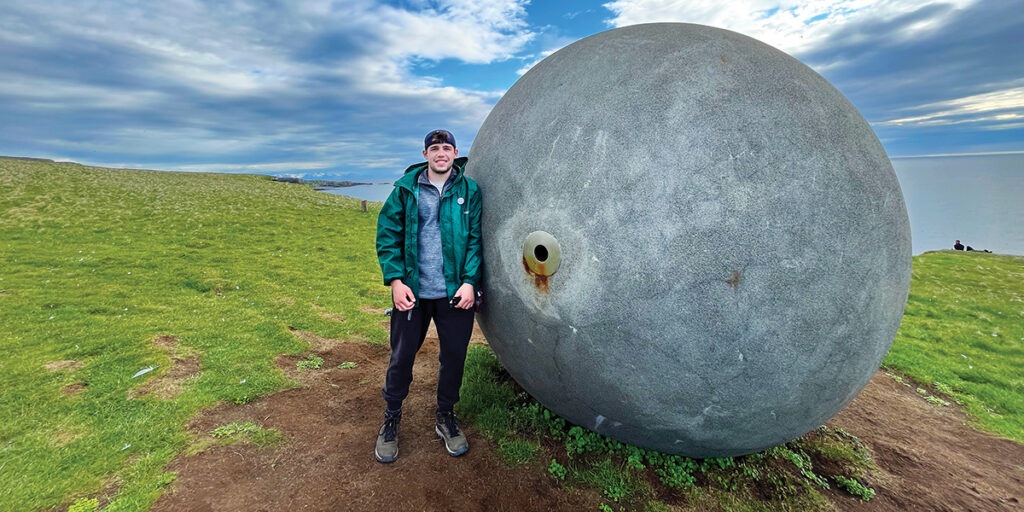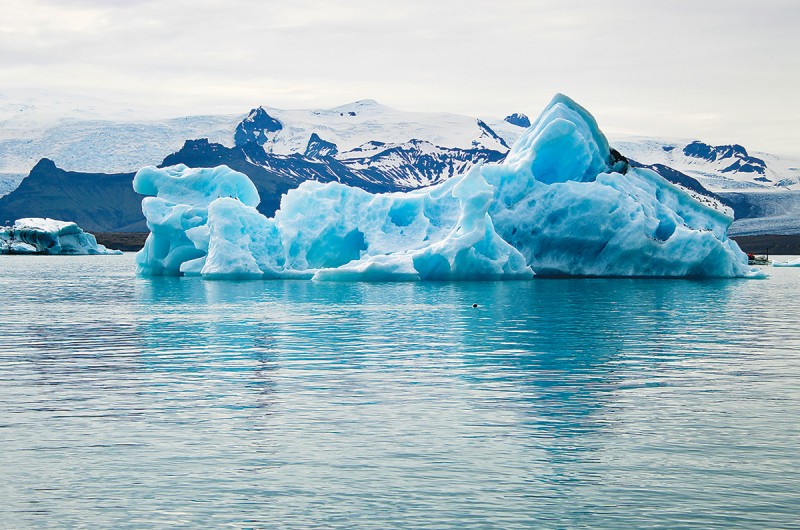SIT Iceland alum gains new understanding of new energy technology
January 11th, 2024 | Alumni, SIT Study Abroad
Binghamton University student Lucas Grabowski studied abroad on SIT Iceland: Renewable Energy, Technology, and Resource Economics. This story was originally published on the Binghamton College website. It is reprinted here with permission.
- Learn more about SIT Iceland: Renewable Energy, Technology, and Resource Economics

By Tasfia Rubayat
When Lucas Grabowski ’23 returned to the Thomas J. Watson College of Engineering and Applied Science as a senior after a summer in Iceland, he brought with him a new understanding of renewable energy technology.
The mechanical engineering major from Syracuse, N.Y., traveled to the Land of Fire and Ice shortly after finishing his last final exam. Upon his arrival, he began an intensive 9-credit course, jam-packed with traveling, sightseeing, and traditional class time.
“They didn’t really give us a lot of information going into it, but it was very laid out and structured once we got there,” Grabowski says. “They had our housing and transportation all taken care of, so they were really focused on us learning and taking it all in and having a great experience, rather than having to figure out all the logistics.”
Iceland has plans to reach carbon neutrality by 2040, making this particular education-abroad program a perfect match for Grabowski and his interest in the renewable energy sector.
I looked at how we can create a local power source there. A pumped hydropower plant could be powered by a local wind farm. They also have a lot of channels in the northern region of Iceland, so I was thinking about a tidal barrage that would spin a turbine and produce energy.
Run by School of International Training, the program unfolded across four hub locations. Grabowski and other American students—including six additional Binghamton University students in different fields of study—visited and toured several geothermal and hydroelectric plants, wind and solar farms, and Icelandic parks to learn more about the region’s unique geology.

“Geothermal research there is huge because they have so many volcanoes,” Grabowski says. “And they’re on a tectonic plate barrier, so they pull a lot of the heat from there to produce energy.”
Grabowski applied to the program in October 2021 and submitted recommendations, an essay, his GPA and a background check. After receiving his acceptance, he communicated with his professors to ensure the credits from his education-abroad program would count toward his major.
“Students can work with their undergraduate director to assess course equivalents or participate in an already approved program,” says Jennifer Drake-Deese, Watson College’s director of undergraduate advising. “Studying abroad over the summer is an excellent way to have an international experience, fulfill a general education requirement and still stay on track to graduate in four years.”
As an official education-abroad ambassador, Grabowski encourages students, especially those from Watson, to pursue opportunities to study in a different country.
“Don’t say you can’t do it until you actually can’t do it. Just be open to everything,” he says. “There are different opportunities, and you’re not limited to internships over the summer. Not a lot of people know they can do this, especially as a Watson student. I never thought these possibilities existed, but unless you actually see it in action, it seems far from your reach. Now I can take those experiences and apply it to my future career.”
Grabowski and his team members visited the northern region of Westfjords to learn about its unique challenges with energy cost and conservation. Despite having a smaller population than Iceland’s capital city, Westfjords has much greater energy costs.
“They use a lot of diesel generators because they don’t have a great power source from the main grid. They have to adapt in that way and their energy price is higher, even though there aren’t a lot of people,” Grabowski says. “We learned about their challenges there and what their struggles are and the initiatives to combat that.”
He centered his independent research project on the region and worked toward developing plans that may improve its economy while preserving the environment.
“I looked at how we can create a local power source there,” he says. “A pumped hydropower plant could be powered by a local wind farm. They also have a lot of channels in the northern region of Iceland, so I was thinking about a tidal barrage that would spin a turbine and produce energy.”
As he traveled even farther north, Grabowski reached the Arctic Circle and experienced 24 hours of daylight, accompanied by perpetual freezing temperatures.
“We took a boat ride over there. Just seeing the views and the ocean, the mountains, the landscape, and there were puffins everywhere,” he says. “It was like realizing how beautiful the world is and laying the foundation for why we’re here, to learn about renewable energy and how to preserve it.”
In the capital city of Reykjavík, Grabowski was immersed in traditional classroom-style learning. Icelandic professors and industry experts lectured on the technical aspects of renewable energy technology used in the region.
“We learned it in class, then went out and applied it, and for me that was very beneficial,” he says.
In addition to the mechanical and technical side of his research, Grabowski attended a wide range of classes that gave him well-rounded perspectives about the economic and political aspects of the renewable-energy sector.
Just seeing the views and the ocean, the mountains, the landscape, and there were puffins everywhere. It was like realizing how beautiful the world is and laying the foundation for why we’re here, to learn about renewable energy and how to preserve it.
“One big takeaway I noticed was that rather than cutting back on regulations and easing into it, they’re going more aggressive. Over here, it’s more the opposite way,” he says. “They’re seeing it more as an economic way to advance the country rather than just saving the planet. Seeing both sides helps connect people toward a common goal.”
Despite the ambitious academic schedule, Grabowski and his teammates were able to enjoy weekends at their own pace. As an avid hiker, he was eager to pursue adventures that allowed him to take in the natural beauty of Iceland as often as he could.
“We got the weekend off, which was really nice,” he says. “We hiked and they had a lot of natural springs, but one of my favorites was when we hiked 45 minutes up this canyon to a geothermal hot river where the water was like 100 degrees and it was like a natural hot tub.”
Grabowski’s passion for renewable energy is rooted in his appreciation for environmental beauty. Inspired by his trip to Iceland, he hopes to pursue a career related to renewable energy.
“I met Lucas when he was a student in my undergraduate mechanical engineering class, Thermodynamics. It was clear that he had a passion for energy research and development,” says Paul Chiarot, associate professor and chair of the Mechanical Engineering Department. “He did great in my class. I was happy to hear that he was invited for the internship in Iceland. He had the opportunity to learn from world-class experts on energy generation and efficiency, with the goal of bringing this knowledge back to New York.”
As part of the program, Grabowski developed two case studies, based in New York and New Jersey, that applied different renewable energy methods to gauge economic and social feasibility. He spoke with professors in Iceland to learn how to calculate power production numbers and their suggestions to state governments about reaching carbon neutrality.
He had the opportunity to learn from world-class experts on energy generation and efficiency, with the goal of bringing this knowledge back to New York.
Associate Professor Paul Chiarot, chair of the Mechanical Engineering Department
“We wanted to know how much power we would need to produce to go 100 percent renewable energy in New Jersey and New York, and it was crazy to see that we need a lot,” he says. “It’s not super-feasible, so it just shows that it’s a collective effort to cut down on the carbon that we use here.”
Grabowski looks forward to applying what he learned in Iceland to environmental preservation efforts in the U.S.
“It’s very inspiring to see that these things can happen—people are actually doing it. That was why I wanted to go over there and bring some of that knowledge back,” he says. “It’s our generation that is tackling this problem because we are seeing all the effects of climate change. It’s our turn to step up to the plate and do something about it.”
